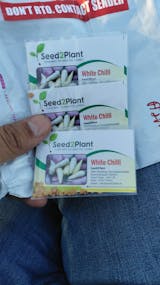


Product Description - Organic White Chilli Seeds - Open Pollinated
The white Chilli is a chilli of a long sized family of capsicum. While they are most widely used for frying and salads, they can also be used to be preserved and frozen. The reality is, for many of you, uncooked is more appealing and is used is exotic south Indian dishes. Like green chilli, it is high in vitamin B6, A, copper, potassium, and iron but contains a little protein and carbohydrates. You can eat it raw, fried, or roasted with salads and as a side dish in your main meals because it is high in capsaicin, a chemical compound that gives chilli peppers their spicy flavour.
Benefits/Uses of White Chilli
- As with most peppers, the White Chilli is high in vitamin C, which helps the immune system.
- Additionally, there is a healthy dosage of vitamin A, iron, and capsaicin, the component of chilli peppers that gives them their spiciness.
- This molecule is anti-inflammatory and has several beneficial properties, including increasing metabolism.
- Additionally, studies indicate that capsaicin may help lessen the risk of cancer.
Specifications of White Chilli Seeds
|
Common name |
White Chilli |
|
Sunlight |
Minimum of 5 hours per day |
|
Water |
Don't overwater; watering with a sprayer causes more impact |
|
Temperature |
65-80 deg |
|
Soil |
Loam soil |
|
Fertilizer |
Organic fertilizer |
|
Germination |
8-14 days |
|
Harvest season |
· About 90 days after chilly has flowered · All seasons |
| No. of seeds | 30+ |
Planting and Care for White Chilli
Sowing White Chilli Seeds
- Chillies require little root space, and as long as the soil is at least 20cm deep, they should thrive.
- Fill your grow bag halfway with Vegetable and Fruit Mix or Potting Mix - 100% Organic with 8 Fertilizers and 4 Beneficial Microbes.
- Before sowing the seeds, prepare the soil bed with exfoliated Vermiculite.
- After sowing seeds, properly water plants and allow for drainage.
- Replenish your container with seed2plant vegetables and fruits. Combine to a depth of 3cm from the top.
- Increase root development and metabolism in your plants and seed germination by using a humic acid growth promoter.
- Keep your plant well-watered.
Growing White Chilli
- Provide nourishment for your plants, and they will provide nourishment for you. Because plants absorb nutrients from the soil as they grow, replacing them guarantees that your plants reach their maximum potential.
- Use A2 Desi Cow Panchagavya Organic Growth Promoter to chillies sown in grow bags. Maintain adequate moisture in the soil throughout the growing season.
- While your chillies are developing typically, give them a boost with a dosage of Seaweed Extract Liquid Growth Promoter.
- Chillies that are well-watered and well-nourished have a better chance of warding off insect pests and diseases.
Harvesting White Chilli
- Chillies mature in around three months.
- When the chillies are ready, cut them from the plants - do not pull them from the plant as they will frequently rip—the colour and flavour of the plant change as it grows.
Precautions while growing White Chilli
- Eliminate any weeds that have established themselves around the chilli plant.
- Flowers are harmed by high heat and wind.
- Use Garden Agro Shade Net 50% Shade UV Stabilized if it is too sunny.
- The planting timing should be determined during the day.
- This plant thrives when the daytime temperature is between 65 and 80 degrees Fahrenheit.
Common Problems affecting White Chilli Plants and Solutions
Maintain vigilance and prevent unwelcome insects and illnesses from wreaking havoc on your plants. Slugs and snails can be a problem; safeguard young plants with bio pest control for sucking and biting pests.
Small whiteflies feed on the sap of the plant and excrete sticky "honeydew," which stimulates the growth of sooty mould in the terrace garden, which can be managed biologically using bio pest controller or using sticky traps.
Grey mould is a naturally occurring illness that thrives in moist or humid conditions. Spores enter plants via wounds, damaged tissue, and opened blooms. Mold may wreak havoc on fruit that is beginning to ripen, such as strawberries. Black resting spores survive the winter. The cure for this is to remove any infected plant components immediately. Eliminate hazardous debris and surgically remove infected areas to expose healthy tissue.
No. of White Chilli Seeds - 50+











